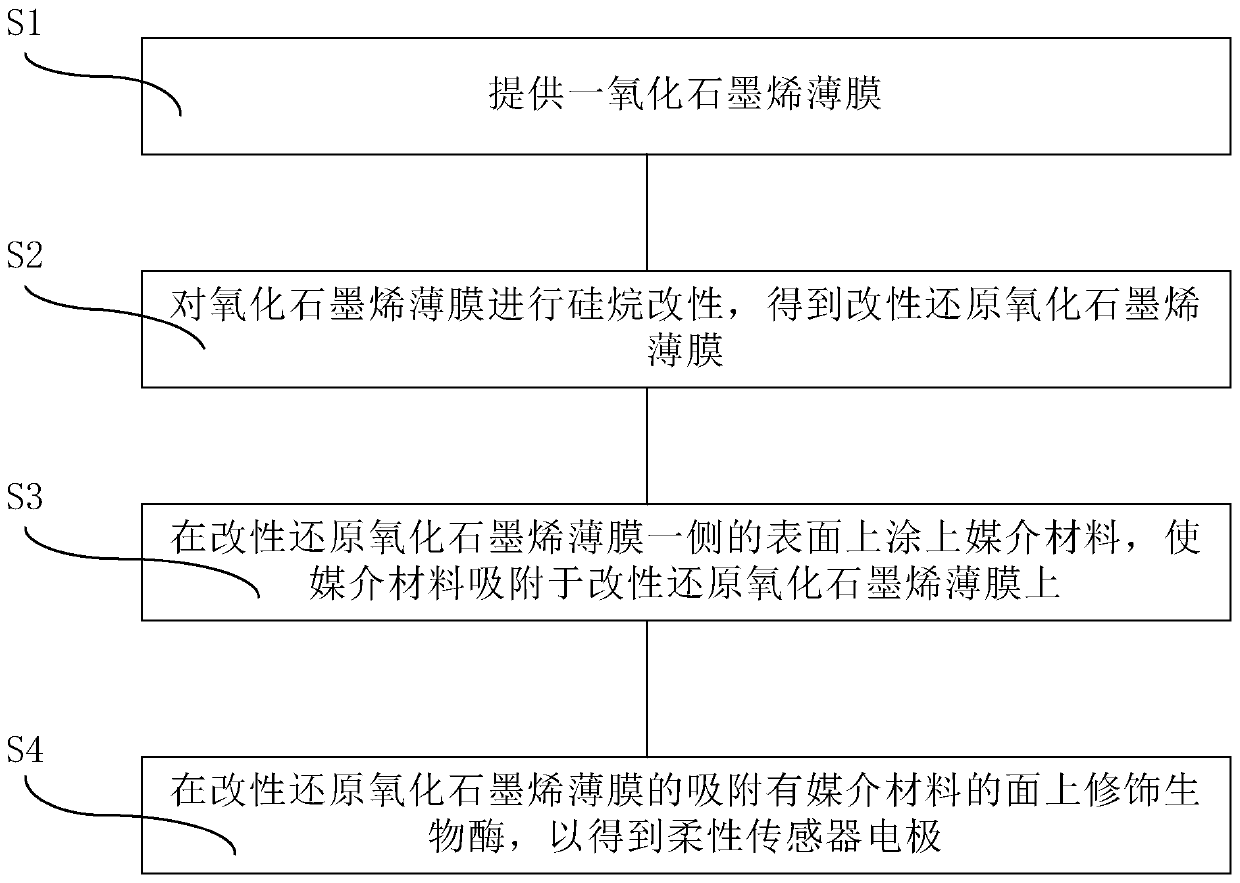Flexible sensor electrode preparation method, flexible sensor electrode and flexible sensor
A flexible sensor and electrode technology, used in biochemical equipment and methods, instruments, scientific instruments, etc., can solve the problems of weak electrode binding force, difficult flexibility, and cumbersome electrochemical polymerization process, so as to achieve flexibility and process. simple effect
- Summary
- Abstract
- Description
- Claims
- Application Information
AI Technical Summary
Problems solved by technology
Method used
Image
Examples
preparation example Construction
[0033] figure 1 Shown is a schematic flow chart of the flexible sensor electrode preparation method provided by the embodiment of the present invention. Such as figure 1 As shown, the flexible sensor electrode preparation method provided by the embodiment of the present invention includes the following steps:
[0034] S1: Provide graphene oxide film;
[0035] S2: performing silane modification on the graphene oxide film to obtain a modified reduced graphene oxide film;
[0036] S3: Coating a medium material on one side of the modified reduced graphene oxide film, so that the medium material is adsorbed on the modified reduced graphene oxide film;
[0037] S4: modifying biological enzymes on the surface of the modified reduced graphene oxide film on which the mediator material is adsorbed to obtain flexible sensor electrodes.
[0038] In this embodiment, the graphene oxide film itself has good flexibility. By modifying the graphene oxide film with silane, on the one hand, ...
Embodiment 1
[0055] Embodiment 1: 100 mg of graphene oxide film with a thickness of 100 μm obtained by suction filtration is placed in a desiccator, and a petri dish filled with 200 μL of 3-aminopropyltriethoxysilane is placed in the desiccator, and after sealing, it is heated at 180 Reaction at ℃ for 3h. After the reaction, the obtained modified reduced graphene oxide film was taken out and vacuumized three times. Prepare 500mg / L methylene blue aqueous solution, and drop-coat it on the surface of one side of the silane-modified reduced graphene oxide film, the dosage is 100μL / cm 2 . After natural drying, it was dipped and washed in deionized water for 3 times, and after drying, the modified reduced graphene oxide film with the media material adsorbed was obtained. Glucose oxidase is dissolved in phosphate buffer (pH=7.2) at a concentration of 10-50 mg / ml, and then mixed with 1% chitosan solution (solvent is 2% acetic acid aqueous solution) according to the volume ratio of 1:2 to obtain ...
Embodiment 2
[0056] Embodiment 2: Embodiment 2 is basically the same as the above embodiment, except that methyltriethoxysilane is used as the reactant for silane modification. Since the modified reduced graphene oxide film after the silane modification is hydrophobic, when the organic dye is adsorbed, the organic dye needs to be dissolved in an organic solvent (such as ethanol) and then drip-coated.
[0057] In summary, the present invention first utilizes silane vapor to carry out synchronous reduction and crosslinking of graphene oxide film to prepare a modified reduced graphene oxide film with electrical conductivity and mechanical strength; Adsorb the media material on the surface of the modified graphene oxide film to form a media layer on the modified reduced graphene oxide film. This method avoids the cumbersome electropolymerization process during the formation of the traditional medium layer, the preparation method is simple, the medium layer and the electrode body can be closely...
PUM
| Property | Measurement | Unit |
|---|---|---|
| thickness | aaaaa | aaaaa |
| pore size | aaaaa | aaaaa |
Abstract
Description
Claims
Application Information
 Login to View More
Login to View More - R&D
- Intellectual Property
- Life Sciences
- Materials
- Tech Scout
- Unparalleled Data Quality
- Higher Quality Content
- 60% Fewer Hallucinations
Browse by: Latest US Patents, China's latest patents, Technical Efficacy Thesaurus, Application Domain, Technology Topic, Popular Technical Reports.
© 2025 PatSnap. All rights reserved.Legal|Privacy policy|Modern Slavery Act Transparency Statement|Sitemap|About US| Contact US: help@patsnap.com

